-
 Nam June Paik sitting on TV Chair
Nam June Paik sitting on TV Chair
-
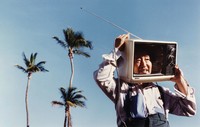 Nam June Paik in Miami
Nam June Paik in Miami
-
 Ommah
Ommah In 2005, the year before his death, Nam June Paik created Ommah (""mother"" in Korean), his last work of video sculpture, a genre that he invented in the early 1960s. The work is a moving summary as well as a lighthearted look back at a long and winding career.
In Ommah, a traditional robe that might have been worn by a well-off Korean boy some 100 years ago hangs nearest to the viewer. Through its lightweight silk, images on an LCD TV monitor can be seen, but not without the irritation of a moiré pattern caused by the interplay of the two ""screens."" The monitor plays a program lasting several minutes and looping continuously. Three Korean American girls in traditional costumes dance, play ball, beat a drum, and ride in a toy car, seemingly carefree but carefully choreographed by Paik. The back-ground imagery includes close-up views of early video games, footage from TV shows, and material from Global Groove, the video Paik made for WNET-TV in 1974, all manipulated using a high-tech version of the color video synthesizer Paik coinvented around 1970. The music includes ambient sounds of the studio, both straight and processed, and snippets from Paik's own experimental music tapes of the 1950s.
As stable and iconic as this cruciform work appears, our physically moving before it is vital as we pass back and forth, trying to peer through or around the robe. Paik attacked the passivity that he felt television imposed on viewers. Through endless play with the medium, he reclaimed the ""boob tube"" as an expressive, democratic tool. A Fluxus-inspired trickster crossing high culture with low, Paik never lost the homemade, improvised quality of his earliest experiments.
To complement this gift of the Collectors Committee, Paik's nephew Ken Hakuta has donated an early work. Untitled (Red Hand), 1967, also employs a found antique as a screen (in this case a 19th-century Japanese scroll painting) through which light (in this case a blinking bulb) is projected. The bulb illuminates a handprint, presumably the artist's own, made on the glass of the frame. The scroll's comical figure with bulging eyes combines with these other elements in a humorous meditation on authorship and scavenger hunting, technology and tradition. Together these two works constitute a landmark acquisition: they are the first sculptural objects by Paik to enter the collection, and Ommah is a key addition to our nascent collection of works in time-based media.
-
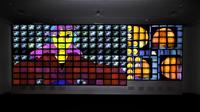 Megatron/Matrix
Megatron/Matrix Megatron Matrix is roughly the size of a billboard and holds 215 monitors. The video—augmented by a loop of unrelated soundbites—mixes images from the Seoul Olympics with Korean folk rituals and modern dance. Smaller clips play simultaneously on multiple monitors, while larger, animated images flow across the boundaries between screens, suggesting a world without borders in the electronic age.
Paik sorted the monitors into two distinct sections. The Megatron conveys the vast reach of the media, while the smaller section, the Matrix, emphasizes the impact on each of us. In Matrix, Paik arranged the monitors so that the images seem to spiral inward around a lone screen showing two partially nude women. He may be suggesting that our bodies are our primal connection to the world, but the effect on the viewer is of being assaulted by "too much information."
In the early 1960s, Paik began incorporating televisions into his collaborative performance pieces with American dancers, musicians, and artists. Today, the fusion of pop music, commercial culture, and nationalist symbols captures Paik's story and that of millions around the world. Paik's prophetic awareness of the power of television has been borne out in our "plugged-in" age, when any kind of art or entertainment is available on our screens all the time.
-
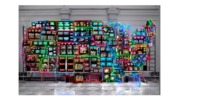 Electronic Superhighway: Continental U.S., Alaska, Hawaii
Electronic Superhighway: Continental U.S., Alaska, Hawaii When Nam June Paik came to the United States in 1964, the interstate highway system was only nine years old, and superhighways offered everyone the freedom to "see the U.S.A. in your Chevrolet." Walking along the entire length of this installation suggests the enormous scale of the nation that confronted the young Korean artist when he arrived. Neon outlines the monitors, recalling the multicolored maps and glowing enticements of motels and restaurants that beckoned Americans to the open road. The different colors remind us that individual states still have distinct identities and cultures, even in today's information age. Paik augmented the flashing images "seen as though from a passing car" with audio clips from The Wizard of Oz, Oklahoma, and other screen gems, suggesting that our picture of America has always been influenced by film and television. Today, the Internet and twenty-four-hour broadcasting tend to homogenize the customs and accents of what was once a more diverse nation. Paik was the first to use the phrase "electronic superhighway," and this installation proposes that electronic media provide us with what we used to leave home to discover. But Electronic Superhighway is real. It is an enormous physical object that occupies a middle ground between the virtual reality of the media and the sprawling country beyond our doors.
-
 Technology
Technology
-
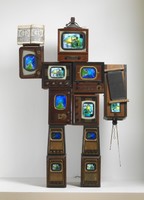 Li Tai Po
Li Tai Po
-
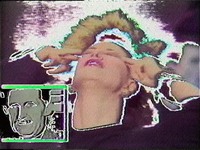 Good Morning Mr. Orwell
Good Morning Mr. Orwell Good Morning Mr.Orwell is an edited version of Paik's first international satellite "installation," which was held on New Year's Day 1984. Paik's transcultural satellite extravaganzas link different countries, spaces, and times in often chaotic but entertaining collages of art and pop culture, the avant-garde and television. Good Morning Mr.Orwell, which Paik saw as a rebuttal to Orwell's dystopian vision of 1984, linked France, Germany and the U.S. The event featured vibrant performances by Laurie Anderson, Merce Cunningham, Peter Gabriel and Allen Ginsberg, among many others. Paik coordinated the event and designed the TV graphics that connected the various live and pre-recorded segments. This project can be seen as a development of Paik's thinking on the potential of satellite communication, as proposed in A Conversation, and realized with his typical pastiche of art, entertainment, and crosscultural juxtapositions.
-
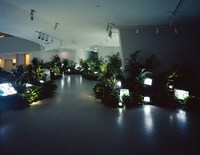 TV Garden
TV Garden No artist had a greater influence in revealing the artistic potential lurking behind television’s flickering facade than Nam June Paik. Commonly hailed as the father of video art, Paik reshaped perceptions of the electronic image through a prodigious output of manipulated TV sets, live performances, global television broadcasts, single-channel videos, and video installations. His career took him from Asia through Europe to the United States, and Paik’s complex media-based art grew out of his early interests in electronics, as well as his foundations in performance and music. Arriving in New York in the mid-1960s, he joined a new generation of artists that was altering the ways in which one interacts with the moving image. Paik became a prominent member of the Fluxus movement, whose principles included the transformation of quotidian actions—like the buttoning and unbuttoning of a coat, as seen in his video Button Happening (ca. 1965)—into art. Quickly emerging at the forefront of this movement, Paik also sought to involve the viewer as an active participant in his performances and installations, and he often introduced elements of surprise and the unfamiliar.
TV Garden, one of his seminal installations, illustrates Paik’s profound grasp of technology’s capacity for composition and the new aesthetic discourse that he helped to create. To enter the piece is to experience an uncanny fusion of the natural and the scientific, as hidden amid an undergrowth of live plants are video monitors of various sizes. All are playing the artist’s 1973 collaboration with John J. Godfrey, Global Groove, which montages performers from around the world into a gyrating visual mix, and the videotape’s sound track serves as musical and spoken counterpoint to the monitors’ flickers of light. TV Garden set a new standard for immersive, site-specific video installations. Restaged for the artist’s exhibition at the Guggenheim Museum in 2000, its influence can be seen decades later in ambient, room-sized installations by such artists as Gary Hill and Bill Viola.
For Paik, the artist should not be limited in seeking new forms of creative expression, but rather the potential for innovation must be continually reimagined. Just as Paik reconceived broadcast television in the 1960s and 1970s in order to “turn it inside out” and deliver a fresh take on this means of communication, Paik turned to laser technology as a novel type of sculptural and installation art at the beginning of the 21st century. He continued to dismantle customary ways of seeing and expand the parameters of art making throughout his career.
-
 Buddha Watching TV
Buddha Watching TV "“The real issue implied in “Art and Technology” is not to make another scientific toy, but how to humanize the technology and the electronic medium, which is progressing rapidly—too rapidly.” —Nam June Paik
Paik, undoubtedly the single most important figure in the history of video art, established the medium in the early 1960s. Buddha Watching TV comes from one of his most celebrated video sculpture series. Paik created the original concept in 1974 and made this example in 1997.
Here a stone Buddha head from Indonesia, partially embedded in dirt and signed dramatically across the back by Paik in Chinese and English, appears to observe itself on television. A live image of the unchanging head is continuously relayed to the monitor by the closed-circuit camera on the tripod. The Buddha thus generates and receives its own image in an infinite temporal loop, updating the act of contemplation for the age of technology."
-
 A Tribute to John Cage
A Tribute to John Cage "A Tribute to John Cage is Paik's homage to avant-garde composer John Cage. A major figure in contemporary art and music, Cage was one of the primary influences on Paik's work, as well as his friend and frequent collaborator. In this multifaceted portrait, Paik creates a pastiche of Cage's performances and anecdotes, interviews with friends and colleagues, and examples of Paik's participatory music and television works that parallel Cage's strategies and concerns. The methodology and philosophies that inform Cage's radical musical aesthetic — chance, randomness, the democratization of sounds — are evident as he performs such seminal pieces as 4'33"" (of complete silence) in Harvard Square, or throws the I Ching to determine performance sites. Among the collage of elements included in this work are segments from Paik's Zen for TV; Paik and Charlotte Moorman in early performances, including the TV Bra; and anecdotes from composer Alvin Lucier.
Host: Russell Connor. Guest: Alvin Lucier. Performers: John Cage, Marianne Amacher, Richard Teitelbaum, Pulsa, Charlotte Moorman, David Behrman, David Tudor. Excerpts of work by Cathy Berberian, Jud Yalkut, Francis Lee, David Rosenboom, Jackie Cassen, Stan VanDerBeek, Alfons Schilling. Produced by the New Television Workshop and the TV Lab at WNET/Thirteen."
-
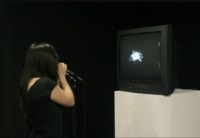 Participation TV
Participation TV This work is one of the 13 experimental televisions shown in Paik’s first solo exhibition in Wuppertal, Exposition of Music—Electronic Television (Germany, 1963). Its earlier form was sheer acoustic, while the later version of Participation TV visualized amplification of sound. When someone speaks or makes a sound into the microphone, the monitor shows several images. The work housed by the Nam June Paik Art Center was re-made in 1998. When someone makes a sound into the microphone, the acoustic signals are transformed into fine electronic signals, which are amplified and displayed as visual patterns. According to the rise and fall and volume of the sounds made by the audience, the lines split into three colors (red, green, and blue) are transformed into images that are not able to be predictable nor repeat themselves.
 Nam June Paik sitting on TV Chair
Nam June Paik sitting on TV Chair
 Nam June Paik in Miami
Nam June Paik in Miami
 Ommah In 2005, the year before his death, Nam June Paik created Ommah (""mother"" in Korean), his last work of video sculpture, a genre that he invented in the early 1960s. The work is a moving summary as well as a lighthearted look back at a long and winding career. In Ommah, a traditional robe that might have been worn by a well-off Korean boy some 100 years ago hangs nearest to the viewer. Through its lightweight silk, images on an LCD TV monitor can be seen, but not without the irritation of a moiré pattern caused by the interplay of the two ""screens."" The monitor plays a program lasting several minutes and looping continuously. Three Korean American girls in traditional costumes dance, play ball, beat a drum, and ride in a toy car, seemingly carefree but carefully choreographed by Paik. The back-ground imagery includes close-up views of early video games, footage from TV shows, and material from Global Groove, the video Paik made for WNET-TV in 1974, all manipulated using a high-tech version of the color video synthesizer Paik coinvented around 1970. The music includes ambient sounds of the studio, both straight and processed, and snippets from Paik's own experimental music tapes of the 1950s. As stable and iconic as this cruciform work appears, our physically moving before it is vital as we pass back and forth, trying to peer through or around the robe. Paik attacked the passivity that he felt television imposed on viewers. Through endless play with the medium, he reclaimed the ""boob tube"" as an expressive, democratic tool. A Fluxus-inspired trickster crossing high culture with low, Paik never lost the homemade, improvised quality of his earliest experiments. To complement this gift of the Collectors Committee, Paik's nephew Ken Hakuta has donated an early work. Untitled (Red Hand), 1967, also employs a found antique as a screen (in this case a 19th-century Japanese scroll painting) through which light (in this case a blinking bulb) is projected. The bulb illuminates a handprint, presumably the artist's own, made on the glass of the frame. The scroll's comical figure with bulging eyes combines with these other elements in a humorous meditation on authorship and scavenger hunting, technology and tradition. Together these two works constitute a landmark acquisition: they are the first sculptural objects by Paik to enter the collection, and Ommah is a key addition to our nascent collection of works in time-based media.
Ommah In 2005, the year before his death, Nam June Paik created Ommah (""mother"" in Korean), his last work of video sculpture, a genre that he invented in the early 1960s. The work is a moving summary as well as a lighthearted look back at a long and winding career. In Ommah, a traditional robe that might have been worn by a well-off Korean boy some 100 years ago hangs nearest to the viewer. Through its lightweight silk, images on an LCD TV monitor can be seen, but not without the irritation of a moiré pattern caused by the interplay of the two ""screens."" The monitor plays a program lasting several minutes and looping continuously. Three Korean American girls in traditional costumes dance, play ball, beat a drum, and ride in a toy car, seemingly carefree but carefully choreographed by Paik. The back-ground imagery includes close-up views of early video games, footage from TV shows, and material from Global Groove, the video Paik made for WNET-TV in 1974, all manipulated using a high-tech version of the color video synthesizer Paik coinvented around 1970. The music includes ambient sounds of the studio, both straight and processed, and snippets from Paik's own experimental music tapes of the 1950s. As stable and iconic as this cruciform work appears, our physically moving before it is vital as we pass back and forth, trying to peer through or around the robe. Paik attacked the passivity that he felt television imposed on viewers. Through endless play with the medium, he reclaimed the ""boob tube"" as an expressive, democratic tool. A Fluxus-inspired trickster crossing high culture with low, Paik never lost the homemade, improvised quality of his earliest experiments. To complement this gift of the Collectors Committee, Paik's nephew Ken Hakuta has donated an early work. Untitled (Red Hand), 1967, also employs a found antique as a screen (in this case a 19th-century Japanese scroll painting) through which light (in this case a blinking bulb) is projected. The bulb illuminates a handprint, presumably the artist's own, made on the glass of the frame. The scroll's comical figure with bulging eyes combines with these other elements in a humorous meditation on authorship and scavenger hunting, technology and tradition. Together these two works constitute a landmark acquisition: they are the first sculptural objects by Paik to enter the collection, and Ommah is a key addition to our nascent collection of works in time-based media. Megatron/Matrix Megatron Matrix is roughly the size of a billboard and holds 215 monitors. The video—augmented by a loop of unrelated soundbites—mixes images from the Seoul Olympics with Korean folk rituals and modern dance. Smaller clips play simultaneously on multiple monitors, while larger, animated images flow across the boundaries between screens, suggesting a world without borders in the electronic age. Paik sorted the monitors into two distinct sections. The Megatron conveys the vast reach of the media, while the smaller section, the Matrix, emphasizes the impact on each of us. In Matrix, Paik arranged the monitors so that the images seem to spiral inward around a lone screen showing two partially nude women. He may be suggesting that our bodies are our primal connection to the world, but the effect on the viewer is of being assaulted by "too much information." In the early 1960s, Paik began incorporating televisions into his collaborative performance pieces with American dancers, musicians, and artists. Today, the fusion of pop music, commercial culture, and nationalist symbols captures Paik's story and that of millions around the world. Paik's prophetic awareness of the power of television has been borne out in our "plugged-in" age, when any kind of art or entertainment is available on our screens all the time.
Megatron/Matrix Megatron Matrix is roughly the size of a billboard and holds 215 monitors. The video—augmented by a loop of unrelated soundbites—mixes images from the Seoul Olympics with Korean folk rituals and modern dance. Smaller clips play simultaneously on multiple monitors, while larger, animated images flow across the boundaries between screens, suggesting a world without borders in the electronic age. Paik sorted the monitors into two distinct sections. The Megatron conveys the vast reach of the media, while the smaller section, the Matrix, emphasizes the impact on each of us. In Matrix, Paik arranged the monitors so that the images seem to spiral inward around a lone screen showing two partially nude women. He may be suggesting that our bodies are our primal connection to the world, but the effect on the viewer is of being assaulted by "too much information." In the early 1960s, Paik began incorporating televisions into his collaborative performance pieces with American dancers, musicians, and artists. Today, the fusion of pop music, commercial culture, and nationalist symbols captures Paik's story and that of millions around the world. Paik's prophetic awareness of the power of television has been borne out in our "plugged-in" age, when any kind of art or entertainment is available on our screens all the time. Electronic Superhighway: Continental U.S., Alaska, Hawaii When Nam June Paik came to the United States in 1964, the interstate highway system was only nine years old, and superhighways offered everyone the freedom to "see the U.S.A. in your Chevrolet." Walking along the entire length of this installation suggests the enormous scale of the nation that confronted the young Korean artist when he arrived. Neon outlines the monitors, recalling the multicolored maps and glowing enticements of motels and restaurants that beckoned Americans to the open road. The different colors remind us that individual states still have distinct identities and cultures, even in today's information age. Paik augmented the flashing images "seen as though from a passing car" with audio clips from The Wizard of Oz, Oklahoma, and other screen gems, suggesting that our picture of America has always been influenced by film and television. Today, the Internet and twenty-four-hour broadcasting tend to homogenize the customs and accents of what was once a more diverse nation. Paik was the first to use the phrase "electronic superhighway," and this installation proposes that electronic media provide us with what we used to leave home to discover. But Electronic Superhighway is real. It is an enormous physical object that occupies a middle ground between the virtual reality of the media and the sprawling country beyond our doors.
Electronic Superhighway: Continental U.S., Alaska, Hawaii When Nam June Paik came to the United States in 1964, the interstate highway system was only nine years old, and superhighways offered everyone the freedom to "see the U.S.A. in your Chevrolet." Walking along the entire length of this installation suggests the enormous scale of the nation that confronted the young Korean artist when he arrived. Neon outlines the monitors, recalling the multicolored maps and glowing enticements of motels and restaurants that beckoned Americans to the open road. The different colors remind us that individual states still have distinct identities and cultures, even in today's information age. Paik augmented the flashing images "seen as though from a passing car" with audio clips from The Wizard of Oz, Oklahoma, and other screen gems, suggesting that our picture of America has always been influenced by film and television. Today, the Internet and twenty-four-hour broadcasting tend to homogenize the customs and accents of what was once a more diverse nation. Paik was the first to use the phrase "electronic superhighway," and this installation proposes that electronic media provide us with what we used to leave home to discover. But Electronic Superhighway is real. It is an enormous physical object that occupies a middle ground between the virtual reality of the media and the sprawling country beyond our doors. Technology
Technology
 Li Tai Po
Li Tai Po
 Good Morning Mr. Orwell Good Morning Mr.Orwell is an edited version of Paik's first international satellite "installation," which was held on New Year's Day 1984. Paik's transcultural satellite extravaganzas link different countries, spaces, and times in often chaotic but entertaining collages of art and pop culture, the avant-garde and television. Good Morning Mr.Orwell, which Paik saw as a rebuttal to Orwell's dystopian vision of 1984, linked France, Germany and the U.S. The event featured vibrant performances by Laurie Anderson, Merce Cunningham, Peter Gabriel and Allen Ginsberg, among many others. Paik coordinated the event and designed the TV graphics that connected the various live and pre-recorded segments. This project can be seen as a development of Paik's thinking on the potential of satellite communication, as proposed in A Conversation, and realized with his typical pastiche of art, entertainment, and crosscultural juxtapositions.
Good Morning Mr. Orwell Good Morning Mr.Orwell is an edited version of Paik's first international satellite "installation," which was held on New Year's Day 1984. Paik's transcultural satellite extravaganzas link different countries, spaces, and times in often chaotic but entertaining collages of art and pop culture, the avant-garde and television. Good Morning Mr.Orwell, which Paik saw as a rebuttal to Orwell's dystopian vision of 1984, linked France, Germany and the U.S. The event featured vibrant performances by Laurie Anderson, Merce Cunningham, Peter Gabriel and Allen Ginsberg, among many others. Paik coordinated the event and designed the TV graphics that connected the various live and pre-recorded segments. This project can be seen as a development of Paik's thinking on the potential of satellite communication, as proposed in A Conversation, and realized with his typical pastiche of art, entertainment, and crosscultural juxtapositions. TV Garden No artist had a greater influence in revealing the artistic potential lurking behind television’s flickering facade than Nam June Paik. Commonly hailed as the father of video art, Paik reshaped perceptions of the electronic image through a prodigious output of manipulated TV sets, live performances, global television broadcasts, single-channel videos, and video installations. His career took him from Asia through Europe to the United States, and Paik’s complex media-based art grew out of his early interests in electronics, as well as his foundations in performance and music. Arriving in New York in the mid-1960s, he joined a new generation of artists that was altering the ways in which one interacts with the moving image. Paik became a prominent member of the Fluxus movement, whose principles included the transformation of quotidian actions—like the buttoning and unbuttoning of a coat, as seen in his video Button Happening (ca. 1965)—into art. Quickly emerging at the forefront of this movement, Paik also sought to involve the viewer as an active participant in his performances and installations, and he often introduced elements of surprise and the unfamiliar. TV Garden, one of his seminal installations, illustrates Paik’s profound grasp of technology’s capacity for composition and the new aesthetic discourse that he helped to create. To enter the piece is to experience an uncanny fusion of the natural and the scientific, as hidden amid an undergrowth of live plants are video monitors of various sizes. All are playing the artist’s 1973 collaboration with John J. Godfrey, Global Groove, which montages performers from around the world into a gyrating visual mix, and the videotape’s sound track serves as musical and spoken counterpoint to the monitors’ flickers of light. TV Garden set a new standard for immersive, site-specific video installations. Restaged for the artist’s exhibition at the Guggenheim Museum in 2000, its influence can be seen decades later in ambient, room-sized installations by such artists as Gary Hill and Bill Viola. For Paik, the artist should not be limited in seeking new forms of creative expression, but rather the potential for innovation must be continually reimagined. Just as Paik reconceived broadcast television in the 1960s and 1970s in order to “turn it inside out” and deliver a fresh take on this means of communication, Paik turned to laser technology as a novel type of sculptural and installation art at the beginning of the 21st century. He continued to dismantle customary ways of seeing and expand the parameters of art making throughout his career.
TV Garden No artist had a greater influence in revealing the artistic potential lurking behind television’s flickering facade than Nam June Paik. Commonly hailed as the father of video art, Paik reshaped perceptions of the electronic image through a prodigious output of manipulated TV sets, live performances, global television broadcasts, single-channel videos, and video installations. His career took him from Asia through Europe to the United States, and Paik’s complex media-based art grew out of his early interests in electronics, as well as his foundations in performance and music. Arriving in New York in the mid-1960s, he joined a new generation of artists that was altering the ways in which one interacts with the moving image. Paik became a prominent member of the Fluxus movement, whose principles included the transformation of quotidian actions—like the buttoning and unbuttoning of a coat, as seen in his video Button Happening (ca. 1965)—into art. Quickly emerging at the forefront of this movement, Paik also sought to involve the viewer as an active participant in his performances and installations, and he often introduced elements of surprise and the unfamiliar. TV Garden, one of his seminal installations, illustrates Paik’s profound grasp of technology’s capacity for composition and the new aesthetic discourse that he helped to create. To enter the piece is to experience an uncanny fusion of the natural and the scientific, as hidden amid an undergrowth of live plants are video monitors of various sizes. All are playing the artist’s 1973 collaboration with John J. Godfrey, Global Groove, which montages performers from around the world into a gyrating visual mix, and the videotape’s sound track serves as musical and spoken counterpoint to the monitors’ flickers of light. TV Garden set a new standard for immersive, site-specific video installations. Restaged for the artist’s exhibition at the Guggenheim Museum in 2000, its influence can be seen decades later in ambient, room-sized installations by such artists as Gary Hill and Bill Viola. For Paik, the artist should not be limited in seeking new forms of creative expression, but rather the potential for innovation must be continually reimagined. Just as Paik reconceived broadcast television in the 1960s and 1970s in order to “turn it inside out” and deliver a fresh take on this means of communication, Paik turned to laser technology as a novel type of sculptural and installation art at the beginning of the 21st century. He continued to dismantle customary ways of seeing and expand the parameters of art making throughout his career. Buddha Watching TV "“The real issue implied in “Art and Technology” is not to make another scientific toy, but how to humanize the technology and the electronic medium, which is progressing rapidly—too rapidly.” —Nam June Paik Paik, undoubtedly the single most important figure in the history of video art, established the medium in the early 1960s. Buddha Watching TV comes from one of his most celebrated video sculpture series. Paik created the original concept in 1974 and made this example in 1997. Here a stone Buddha head from Indonesia, partially embedded in dirt and signed dramatically across the back by Paik in Chinese and English, appears to observe itself on television. A live image of the unchanging head is continuously relayed to the monitor by the closed-circuit camera on the tripod. The Buddha thus generates and receives its own image in an infinite temporal loop, updating the act of contemplation for the age of technology."
Buddha Watching TV "“The real issue implied in “Art and Technology” is not to make another scientific toy, but how to humanize the technology and the electronic medium, which is progressing rapidly—too rapidly.” —Nam June Paik Paik, undoubtedly the single most important figure in the history of video art, established the medium in the early 1960s. Buddha Watching TV comes from one of his most celebrated video sculpture series. Paik created the original concept in 1974 and made this example in 1997. Here a stone Buddha head from Indonesia, partially embedded in dirt and signed dramatically across the back by Paik in Chinese and English, appears to observe itself on television. A live image of the unchanging head is continuously relayed to the monitor by the closed-circuit camera on the tripod. The Buddha thus generates and receives its own image in an infinite temporal loop, updating the act of contemplation for the age of technology." A Tribute to John Cage "A Tribute to John Cage is Paik's homage to avant-garde composer John Cage. A major figure in contemporary art and music, Cage was one of the primary influences on Paik's work, as well as his friend and frequent collaborator. In this multifaceted portrait, Paik creates a pastiche of Cage's performances and anecdotes, interviews with friends and colleagues, and examples of Paik's participatory music and television works that parallel Cage's strategies and concerns. The methodology and philosophies that inform Cage's radical musical aesthetic — chance, randomness, the democratization of sounds — are evident as he performs such seminal pieces as 4'33"" (of complete silence) in Harvard Square, or throws the I Ching to determine performance sites. Among the collage of elements included in this work are segments from Paik's Zen for TV; Paik and Charlotte Moorman in early performances, including the TV Bra; and anecdotes from composer Alvin Lucier. Host: Russell Connor. Guest: Alvin Lucier. Performers: John Cage, Marianne Amacher, Richard Teitelbaum, Pulsa, Charlotte Moorman, David Behrman, David Tudor. Excerpts of work by Cathy Berberian, Jud Yalkut, Francis Lee, David Rosenboom, Jackie Cassen, Stan VanDerBeek, Alfons Schilling. Produced by the New Television Workshop and the TV Lab at WNET/Thirteen."
A Tribute to John Cage "A Tribute to John Cage is Paik's homage to avant-garde composer John Cage. A major figure in contemporary art and music, Cage was one of the primary influences on Paik's work, as well as his friend and frequent collaborator. In this multifaceted portrait, Paik creates a pastiche of Cage's performances and anecdotes, interviews with friends and colleagues, and examples of Paik's participatory music and television works that parallel Cage's strategies and concerns. The methodology and philosophies that inform Cage's radical musical aesthetic — chance, randomness, the democratization of sounds — are evident as he performs such seminal pieces as 4'33"" (of complete silence) in Harvard Square, or throws the I Ching to determine performance sites. Among the collage of elements included in this work are segments from Paik's Zen for TV; Paik and Charlotte Moorman in early performances, including the TV Bra; and anecdotes from composer Alvin Lucier. Host: Russell Connor. Guest: Alvin Lucier. Performers: John Cage, Marianne Amacher, Richard Teitelbaum, Pulsa, Charlotte Moorman, David Behrman, David Tudor. Excerpts of work by Cathy Berberian, Jud Yalkut, Francis Lee, David Rosenboom, Jackie Cassen, Stan VanDerBeek, Alfons Schilling. Produced by the New Television Workshop and the TV Lab at WNET/Thirteen." Participation TV This work is one of the 13 experimental televisions shown in Paik’s first solo exhibition in Wuppertal, Exposition of Music—Electronic Television (Germany, 1963). Its earlier form was sheer acoustic, while the later version of Participation TV visualized amplification of sound. When someone speaks or makes a sound into the microphone, the monitor shows several images. The work housed by the Nam June Paik Art Center was re-made in 1998. When someone makes a sound into the microphone, the acoustic signals are transformed into fine electronic signals, which are amplified and displayed as visual patterns. According to the rise and fall and volume of the sounds made by the audience, the lines split into three colors (red, green, and blue) are transformed into images that are not able to be predictable nor repeat themselves.
Participation TV This work is one of the 13 experimental televisions shown in Paik’s first solo exhibition in Wuppertal, Exposition of Music—Electronic Television (Germany, 1963). Its earlier form was sheer acoustic, while the later version of Participation TV visualized amplification of sound. When someone speaks or makes a sound into the microphone, the monitor shows several images. The work housed by the Nam June Paik Art Center was re-made in 1998. When someone makes a sound into the microphone, the acoustic signals are transformed into fine electronic signals, which are amplified and displayed as visual patterns. According to the rise and fall and volume of the sounds made by the audience, the lines split into three colors (red, green, and blue) are transformed into images that are not able to be predictable nor repeat themselves.